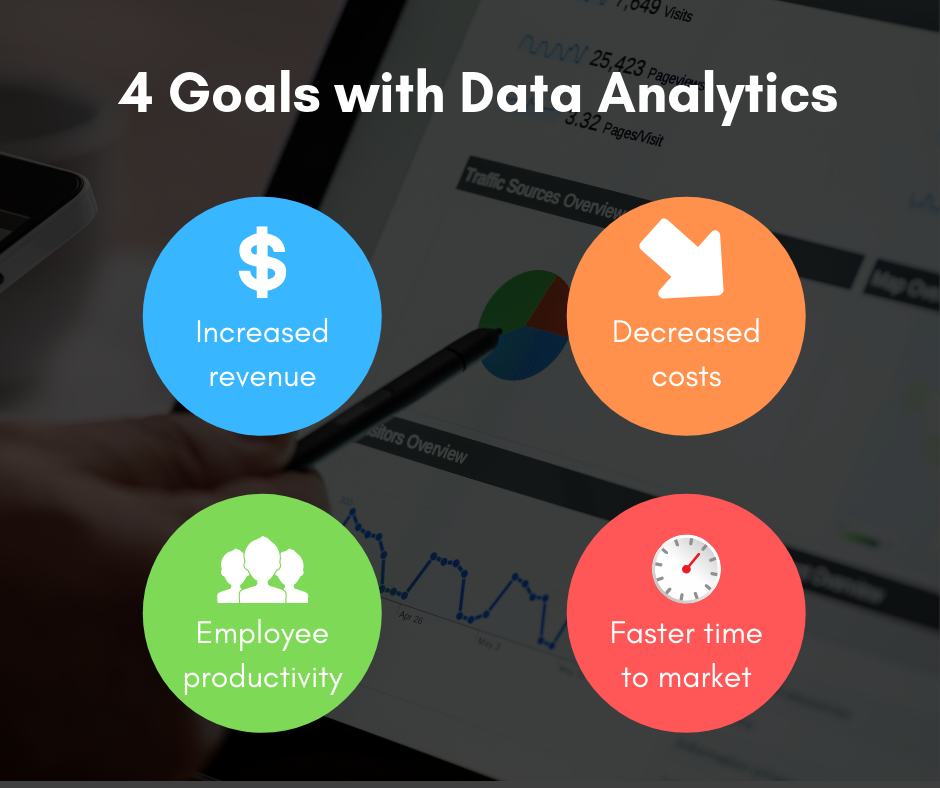So you have a lot of data. And you’ve heard a lot about the importance of being a “data-driven organization.” But your company just can’t seem to connect the dots between the data at hand and making better decisions.
I wrote before about 4 best practices to creating a data-driven culture. But what if your organization doesn’t embrace any of the practices I discussed? Don’t worry – you can become more data-driven. Here are 5 things to focus on to improve your success with gaining insights through data.
1. Orient your data projects towards goals your executives will embrace
If your executive team isn’t embracing data, it’s probably because they can’t see the value in it. Thus, it’s important to reframe your data projects in terms they can understand. One way to do this is to tie projects into your organization’s strategic initiatives. Does your company want to expand into a new geographic market? Is it looking to increase market share by a certain percentage? Is your hospital looking to improve the patient experience? These are all areas in which you can use data to support the initiatives.
In addition, you’ll want to set goals in order to show the value that increased insight from data is bringing to your organization. Below are some areas you can focus on that executives can more easily wrap their heads around.
2. Focus on a few strategic areas at first
When you’re first implementing analytics, it’s important to not try and “boil the ocean.” You’ll have a lot more success if you zone in on a few strategic areas. Once you’ve been able to demonstrate success in these areas, you can expand your analytics implementation to other departments.
Which areas could be most impacted by data projects? Here are a few criteria to consider.
- Pick strategic projects that speak most directly to the goals listed above. They are easier to understand and derive value from.
- Select projects in departments that have “data champions” in them. These people have a greater facility with data, can better translate data into actionable insight, and can better demonstrate the value to others.
- Similarly, seek out high-level executives who are more data inclined. These people have the knowledge to understand the value of data, and they have the clout to influence other executives on why data-driven decision making is important.
3. Make sure departments agree on data definitions
If you work in a hospital, how do you define a “patient day”? Is that consistent across departments? Many times, the clinical definition is different than the financial definition.
It’s important that definitions – whether they pertain to patient data in a hospital, inventory in manufacturing, or sales in a business setting – are all consistent across departments. Otherwise, the arguing that will take place over the definitions will diminish the value of the data insights. If you can’t agree on the data foundation, how will you agree on what the data is telling you?
Some organizations convene a meeting (or more accurately, several meetings) between departments to agree on definitions. Others take a faster route by implementing pre-built definitions – such as those found in Diver Platform’s Measure Factory – that they can later customize.
4. Invest in education
If you feel as though you’re not as data-savvy as you’d like to be, why not invest in educating yourself on analytics? Many universities are now offering analytics master’s or certification programs – and many of them are being offered online.
However, analytics education doesn’t require a degree, and it doesn’t have to be costly. Websites such as Coursera and edX offer free analytics courses, with the option to pay a course fee for a certificate.
In addition, many companies invest in “Train the Trainer” programs. In these programs, one person at an organization will be formally trained in analytics and will then train other employees. This is beneficial in that it assures that an organization will always have an “in-house” analytics resource.
 5. Just do it
5. Just do it
Of course, when it comes down to it, you just need to take that step forward with your data. Even if you’re not quite sure where to get started or which projects would be most valuable, take inventory of what you have. Once you actually visualize what data you have access to, it can be easier to wrap your head around where to take it from there. What trends do you see? What surprises you in the data? Those surprises might prove to be the ideal launch point for your analytics project.
Conclusion
Data provides organizations with a competitive edge in business today. Those organizations that can successfully harness their data and gain insights from it will see higher revenue, lower operating costs, improved employee productivity, and faster time to market. If your organization isn’t “data driven” today, it can get there. The key is to find the right projects in your organization, the right people to drive them, and the right executives to champion them.
Related Reading:
- 4 Best Practices to Creating a Data-Driven Culture
- How Culture Can Positively Impact Healthcare Outcomes
- Solving Hospital CEOs’ Pressing Challenges With Analytics - April 15, 2024
- Navigating the Wellness Wave: Wine & Spirits Data Strategy - April 9, 2024
- Takeaways from HIMSS24 - March 26, 2024




